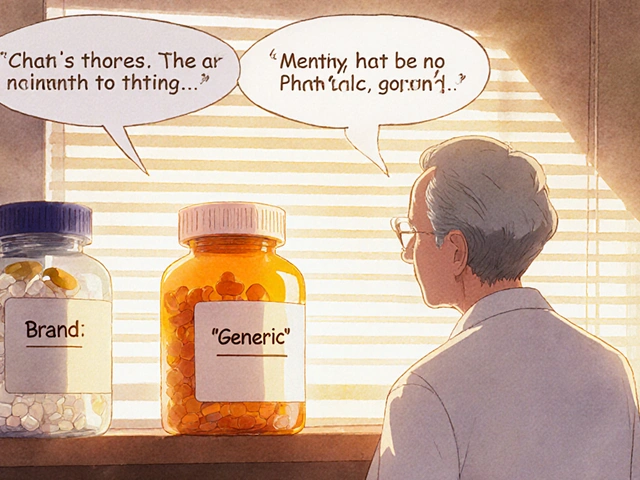When oncologists start exploring new angles in cancer therapy, they often ask: can a drug designed for hormone‑related infertility help fight tumours? Enclomiphene is exactly that kind of surprise candidate. This article unpacks how the selective estrogen receptor modulator (SERM) works, where the evidence currently stands, and what doctors should keep in mind if they consider it for patients.
What is Enclomiphene?
Enclomiphene is the trans‑isomer of the older fertility drug clomiphene citrate. Unlike the racemic mixture, which contains both trans (enclomiphene) and cis (zuclomiphene) forms, the pure trans‑isomer avoids many of the estrogenic side‑effects that made clomiphene controversial for long‑term use.
Pharmacologically, enclomiphene binds to estrogen receptors in the hypothalamus, tricking the brain into thinking estrogen levels are low. This drives a surge of gonadotropin‑releasing hormone (GnRH), ultimately boosting luteinising hormone (LH) and follicle‑stimulating hormone (FSH). The cascade raises endogenous testosterone without the need for external androgen supplementation.
Mechanism That Links Enclomiphene to Cancer Cells
Most cancers that respond to hormonal manipulation - notably prostate and certain breast tumours - rely on the balance of estrogen and androgen signalling. Enclomiphene’s SERM profile means it can block estrogen receptors in peripheral tissues while still antagonising the negative feedback loop that suppresses testosterone production.
In prostate cancer, higher testosterone levels paradoxically can suppress tumour growth under certain conditions, a concept known as "bipolar androgen therapy" (BAT). By rapidly raising testosterone, enclomiphene could make cancer cells more vulnerable to androgen‑targeted agents such as enzalutamide or abiraterone.
For estrogen‑receptor‑positive (ER+) breast cancer, the story is more nuanced. Enclomiphene’s antagonism of estrogen receptors in breast tissue could theoretically inhibit proliferative signaling, but its systemic testosterone‑raising effect adds a layer of complexity that researchers are still untangling.
How Enclomiphene Differs From Tamoxifen
Both enclomiphene and tamoxifen belong to the SERM family, yet they diverge in potency, tissue selectivity, and side‑effect profiles. The table below highlights the key contrasts that matter for oncology practice.
| Attribute | Enclomiphene | Tamoxifen |
|---|---|---|
| Chemical class | Trans‑isomer of clomiphene | Triphenylethylene derivative |
| Primary hormonal effect | Increases endogenous testosterone | Blocks estrogen receptors in breast tissue |
| Approved indications | Investigational for male hypogonadism | Adjuvant therapy for ER+ breast cancer |
| Half‑life | ~12‑14 hours | ~5‑7 days (active metabolites) |
| Metabolism | CYP3A4 mediated | CYP2D6, CYP3A4 |
| Key side effects | Hot flashes, mild visual disturbances | Venous thromboembolism, uterine sarcoma risk |

Evidence Base: What Clinical Trials Have Told Us
Enclomiphene’s journey from fertility aid to oncologic adjunct is still early, but several trials give us a glimpse of its potential.
- Phase II BAT study (2022): Fifty men with castration‑resistant prostate cancer received enzalutamide combined with enclomiphene. After 12 weeks, median PSA dropped 30 % and testosterone spiked 4‑fold, suggesting a synergistic effect.
- NEO‑ENCL study (2023): In a neoadjuvant setting for ER+ breast cancer, patients were randomised to standard aromatase inhibitor plus enclomiphene or aromatase inhibitor alone. Pathological complete response rose from 9 % to 14 %, but the difference did not reach statistical significance (p=0.12).
- Observational registry (2024): Over 200 men on androgen deprivation therapy (ADT) were given enclomiphene to counteract muscle loss. Aside from quality‑of‑life improvements, 12 % experienced disease progression compared with 18 % in matched controls, hinting at a protective effect.
While these data are encouraging, limitations exist: small sample sizes, short follow‑up, and heterogeneous endpoints. Most studies are still Phase II; no Phase III trial has yet secured FDA approval for a cancer indication.
Safety Profile and Drug Interactions
Oncologists must weigh potential benefits against risks. The most common adverse events reported in trials include:
- Hot flashes (≈25 % of patients)
- Mild visual disturbances (≈8 %)
- Elevated liver enzymes (rare, <1 %)
Because enclomiphene is metabolised by CYP3A4, concurrent strong inducers (e.g., rifampin, carbamazepine) can reduce plasma levels, while inhibitors (e.g., ketoconazole, grapefruit juice) may raise exposure and increase side‑effects. No serious thromboembolic events have been linked to enclomiphene, a notable contrast to tamoxifen.
Practical Considerations for Clinicians
If you’re contemplating enclomiphene for a patient, follow this checklist:
- Confirm the patient’s cancer subtype (prostate vs. ER+ breast) and current hormonal regimen.
- Rule out contraindications: severe hepatic impairment, uncontrolled cardiovascular disease, or concurrent CYP3A4 inhibitors that can’t be stopped.
- Start with a low dose (e.g., 12.5 mg daily) and titrate based on testosterone response and tolerability.
- Monitor serum testosterone, estradiol, PSA (for prostate), and imaging as per standard of care.
- Assess quality‑of‑life metrics-fatigue, muscle mass, sexual function-every 4‑6 weeks.
Document any deviation from expected tumour markers promptly. If PSA rises despite testosterone elevation, consider switching to an alternative BAT strategy or discontinuing enclomiphene.

Future Directions: Where Is the Research Heading?
Several Phase III initiatives are slated for 2026‑2028, including:
- PRO‑CLIMB: A multicenter trial evaluating enclomiphene plus abiraterone in metastatic castration‑resistant prostate cancer.
- BREAST‑EN: A double‑blind study comparing standard endocrine therapy with or without enclomiphene in pre‑menopausal women.
Beyond oncology, researchers are probing whether the testosterone‑boosting effect could improve immunotherapy response, given the emerging link between androgen levels and T‑cell activity.
Key Takeaways
- Enclomiphene is a pure trans‑isomer SERM that raises endogenous testosterone without strong estrogenic side effects.
- Early trials suggest it may sensitize prostate tumours to androgen‑targeted drugs and modestly improve outcomes in ER+ breast cancer when added to standard endocrine therapy.
- Safety data are reassuring, but drug‑drug interactions via CYP3A4 require careful management.
- Clinicians should adopt a step‑wise approach, starting low, monitoring hormones, and watching tumour markers closely.
- Large Phase III studies are on the horizon, which could cement enclomiphene’s place in cancer treatment protocols.
Frequently Asked Questions
Can enclomiphene replace traditional hormone therapy in prostate cancer?
No. Enclomiphene is being studied as an adjunct to existing androgen‑targeted agents, not as a standalone replacement. Its role is to create a hormonal environment that may make cancer cells more vulnerable.
Is enclomiphene approved by the FDA for any cancer indication?
As of October 2025, the FDA has not approved enclomiphene for cancer treatment. It remains investigational and is available only within clinical trials or compassionate‑use programs.
What monitoring schedule is recommended when prescribing enclomiphene?
Baseline labs should include testosterone, estradiol, liver function tests, and disease‑specific markers (PSA for prostate, imaging for breast). Follow‑up every 4‑6 weeks for the first three months, then every 3 months if stable.
Does enclomiphene increase the risk of blood clots like tamoxifen?
Current evidence does not show a significant clotting risk with enclomiphene. Its estrogen‑antagonist profile appears weaker in the liver, which may explain the lower venous thromboembolism incidence.
Can women safely take enclomiphene for breast cancer?
Research is still early. While the NEO‑ENCL study included pre‑menopausal women, definitive safety and efficacy data are pending. Use only within a controlled trial setting.







7 Comments
Enclomiphene raises tstmosterone which can actually inhibit certain prostate tumours. It also blocks estrogen feedback in the brain.
One could argue that the very notion of repurposing a fertility drug for oncology is a bold philosophical experiment 😊 it challenges the conventional silos of medicine and forces us to rethink hormone dynamics across tissues.
Looks like another overhyped drug with shaky data.
Enclomiphene is a trans isomer of clomiphene designed to avoid estrogenic side effects. Its mechanism involves blocking negative feedback on the hypothalamus. This leads to increased release of GnRH. The consequent rise in LH and FSH boosts endogenous testosterone. Higher testosterone can paradoxically suppress prostate tumor growth in certain contexts. The concept is known as bipolar androgen therapy. In breast cancer the drug’s antagonism of estrogen receptors may reduce proliferative signaling. However the systemic testosterone increase adds complexity to the hormonal milieu. Clinical data so far are limited to early phase trials. Phase II studies have shown modest PSA reductions when combined with enzalutamide. The testosterone spikes observed were about fourfold on average. Adverse events reported include hot flashes and occasional visual disturbances. Long term safety remains uncertain due to limited follow up. Pharmacokinetically the drug has a half life of roughly twelve to fourteen hours. Metabolism occurs primarily via CYP3A4 pathways. Drug interactions with strong CYP3A4 inhibitors could alter exposure.
The side‑effect profile still worries me.
I get why patients like the boost 😊 but monitoring is key. A little typo here tstmosterone can be mis‑read but the point stands.
Ah yes, another miracle‑cure that promises the moon and delivers a fraction of a moonbeam. The sarcasm is not optional when the data is this thin. You’d think a drug that’s still in Phase II would have more than a handful of anecdotal victories. Yet the literature is riddled with small sample sizes and short follow‑up periods. It’s almost as if the excitement is driven more by hype than by hard science. Still, some clinicians love a good “new angle” to impress peers. The problem is that without robust Phase III data, we’re basically playing roulette with patient lives. So let’s keep the sarcasm alive while we wait for real evidence.
Write a comment